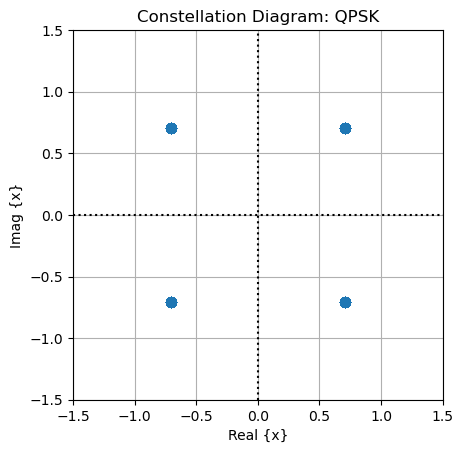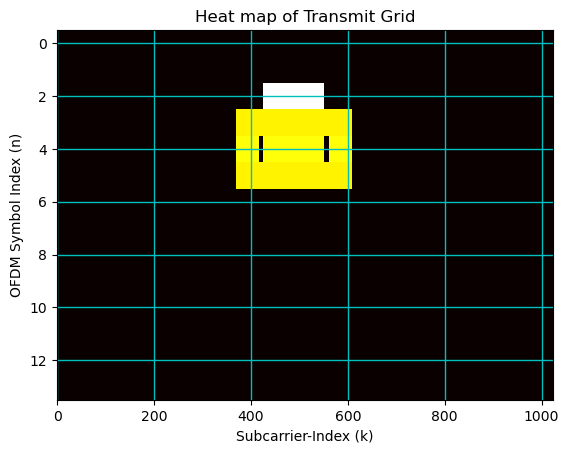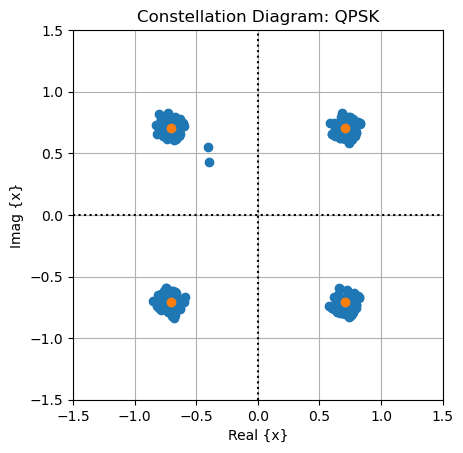7. Physical Broadcast Channel in 5G Networks
The Physical Broadcast Channel (PBCH) carries the Master Information Block (MIB). The MIB contains essential information for downlink synchronization of user equipment, such as cell identity, system bandwidth, and configurations of other channels. In this experiment, the complete implementation of the PBCH chain is discussed in detail.
7. Import Libraries
7. Import Python and SDR Libraries
[1]:
# %matplotlib widget
import os
os.environ["CUDA_VISIBLE_DEVICES"] = "-1"
os.environ['TF_CPP_MIN_LOG_LEVEL'] = '3'
import numpy as np
import tensorflow as tf
import sionna as sn
import adi
import matplotlib.pyplot as plt
7. Import 5G Toolkit Libraries
[2]:
import sys
sys.path.append("../../../../")
from toolkit5G.SequenceGeneration import PSS, SSS, DMRS
from toolkit5G.PhysicalChannels import PBCH
from toolkit5G.ResourceMapping import SSB_Grid, ResourceMapperSSB
from toolkit5G.OFDM import OFDMModulator
from toolkit5G.MIMOProcessing import AnalogBeamforming
from toolkit5G.Configurations import TimeFrequency5GParameters, GenerateValidSSBParameters
from toolkit5G.ReceiverAlgorithms import PSSDetection, SSSDetection, ChannelEstimationAndEqualizationPBCH, DMRSParameterDetection, CarrierFrequencyOffsetEstimation
from toolkit5G.OFDM import OFDMDemodulator
from toolkit5G.PhysicalChannels import PBCHDecoder
7. Import PBCH Components
[3]:
from toolkit5G.PayloadGeneration import MIBGeneration
from toolkit5G.PayloadGeneration import MIBExtraction
from toolkit5G.PhysicalChannels.PBCH import PBCHInterleaver
from toolkit5G.PhysicalChannels.PBCH import PBCHDeInterleaver
from toolkit5G.ChannelCoder.PolarCoder import InputBitInterleaver
from toolkit5G.ChannelCoder.PolarCoder import InputBitDeInterleaver
from toolkit5G.Ratematcher.PolarCoder import Subblock_Interleaver
from toolkit5G.Ratematcher.PolarCoder import Subblock_DeInterleaver
from toolkit5G.Ratematcher.PolarCoder import ChannelDeInterleaver
from toolkit5G.Ratematcher.PolarCoder import ChannelInterleaver
from toolkit5G.Ratematcher.PolarCoder import BitSelection
from toolkit5G.Ratematcher.PolarCoder import BitDeSelection
from toolkit5G.ChannelCoder import PolarEncoder5G
from toolkit5G.ChannelCoder import PolarDecoder5G
# from ChannelCoder.PolarCoder.polarEncoder5G import InputBitDeInterleaver
from toolkit5G.Scrambler import Scrambler
from toolkit5G.Scrambler import DeScrambler
from toolkit5G.CRC import CRCEncoder
from toolkit5G.CRC import CRCDecoder
from toolkit5G.SymbolMapping import Demapper
from toolkit5G.SymbolMapping import Mapper
7. Emulation Configurations
[4]:
# System Parameters
center_frequency = 1e9 # Carrier frequency for signal transmission
# OFDM Parameters
Bandwidth = 10*10**6 # bandwidth
fftSize = 1024 # FFT-size for OFDM
subcarrier_spacing = 30000 # Subcarrier spacing
numOFDMSymbols = 14 # Number of OFDM symbols considered for emulation | 1 slot
sample_rate = fftSize*subcarrier_spacing # sample rate required by OFDM and DAC/ADC of SDR
# Pulse Shaping
numSamplesPerSymbol = 1
# number of samples returned per call to rx()
buffer_size = int(4*fftSize*1.2*numSamplesPerSymbol*numOFDMSymbols)
7. PBCH Payload Generation: MIB + ATI
[5]:
nSymbolFrame= 140*int(subcarrier_spacing/15000); # Number of OFDM symbols per frame (Its a function of subcarrier spacing)
## This class fetches valid set of 5G parameters for the system configurations
tfParams = TimeFrequency5GParameters(Bandwidth, subcarrier_spacing, fftsize = fftSize)
tfParams(nSymbolFrame, typeCP = "normal")
nRB = tfParams.numRBs # SSB Grid size (Number of RBs considered for SSB transition)
Neff = tfParams.Neff # Number of resource blocks for Resource Grid ( exclude gaurd band | offsets : BWP)
fftsize = tfParams.fftsize # FFT-size for OFDM
lengthCP = tfParams.lengthCP # CP length
#### Generate MIB Information
lamda = 3e8/center_frequency;
nSCSOffset = 1
ssbParameters = GenerateValidSSBParameters(center_frequency, nSCSOffset, isPairedBand = False,
intraFrequencyReselection = "allowed",
withSharedSpectrumChannelAccess = False,
ssbSubCarrierOffset = 0)
systemFrameNumber = ssbParameters.systemFrameNumber
subCarrierSpacingCommon = ssbParameters.subCarrierSpacingCommon
ssbSubCarrierOffset = ssbParameters.ssbSubCarrierOffset #ssbParameters.ssbSubCarrierOffset
DMRSTypeAPosition = ssbParameters.DMRSTypeAPosition
controlResourceSet0 = ssbParameters.controlResourceSet0
searchSpace0 = ssbParameters.searchSpace0
isPairedBand = ssbParameters.isPairedBand
nSCSOffset = ssbParameters.nSCSOffset
choiceBit = ssbParameters.choiceBit
ssbType = ssbParameters.ssbType
nssbCandidatesInHrf = 4 #ssbParameters.nssbCandidatesInHrf
ssbIndex = ssbParameters.ssbIndex
hrfBit = ssbParameters.hrfBit
cellBarred = ssbParameters.cellBarred
intraFrequencyReselection = ssbParameters.intraFrequencyReselection
withSharedSpectrumChannelAccess = ssbParameters.withSharedSpectrumChannelAccess
nFrames = 0.5
Nsc_ssb = 240 # Numbers of subcarriers in SSB
Nsymb_ssb = 4 # Numbers of OFDM symbols in SSB
7. PSS, SSS, PBCH, DMRS Generation
[6]:
N_ID2 = np.random.randint(3) # N_ID2 can take values of 0,1 and 2.
# Generate PSS sequence
pssObject = PSS(N_ID2);
pssSequence = pssObject() # PSS sequence
N_ID1 = np.random.randint(336) # N_ID1 can take values ranging from 0 to 335.
N_ID = 3*N_ID1 + N_ID2 # Calculating Physical Cell ID.
# Generate SSS sequence
sssObject = SSS(N_ID1, N_ID2)
sssSequence = sssObject() # SSS Sequence
# Generate DMRS sequence
dmrsLen = 144 # length of DMRS sequence.
dmrsObject = DMRS("PBCH", N_ID, ssbIndex, nssbCandidatesInHrf, hrfBit)
dmrsSequence = dmrsObject(dmrsLen) # DMRS sequence
7. PBCH: Transmitter
[7]:
# *********************************************************************************
#
# # Generate PBCH symbols
# pbchObject = PBCH(center_frequency, choiceBit, subCarrierSpacingCommon, DMRSTypeAPosition,
# controlResourceSet0, searchSpace0, cellBarred, intraFrequencyReselection,
# systemFrameNumber, ssbSubCarrierOffset, hrfBit, ssbIndex, N_ID,
# nssbCandidatesInHrf)
#
# pbchSymbols = pbchObject() # PBCH payload symbol (QPSK modulated)
#
# *********************************************************************************
mib = MIBGeneration(center_frequency, choiceBit, subCarrierSpacingCommon, DMRSTypeAPosition,
controlResourceSet0, searchSpace0, cellBarred, intraFrequencyReselection,
systemFrameNumber, ssbSubCarrierOffset, hrfBit, ssbIndex)
payloadMIB = mib()
pbchIL = PBCHInterleaver()
ilBits = pbchIL(payloadMIB)
pbchScr = Scrambler("PBCH-1", N_ID, nssbCandidatesInHrf)
scrBits = pbchScr(ilBits)
crcEncoder = CRCEncoder("CRC24C")
payloadCRC = crcEncoder(scrBits)
pbch_IiL = InputBitInterleaver()
iILBits = pbch_IiL(payloadCRC)
K = iILBits.shape[1]
E = 864
purpose = "PBCH"
verbose = 0
encoder = PolarEncoder5G(K, E, purpose, verbose)
encBits = encoder(iILBits)
N = encBits.shape[1]
sbBIL = Subblock_Interleaver()
sbBil_bits = sbBIL(encBits)
rm = BitSelection(K, N, E)
rmBits = rm(sbBil_bits)
chIL = ChannelInterleaver()
chIL_bits = chIL(rmBits)
pbchScr2 = Scrambler("PBCH-2", N_ID, nssbCandidatesInHrf, ssbIndex)
scr2Bits = pbchScr2(chIL_bits)
# The mapper maps blocks of information bits to constellation symbols
modOrder = 2
mapper = Mapper("qam", modOrder)
pbchSymbols= mapper(scr2Bits)
7. Constellation Diagram: Base Station
[8]:
fig, ax = plt.subplots()
ax.set_aspect(True)
ax.scatter(np.real(pbchSymbols), np.imag(pbchSymbols), s=48)
ax.grid()
ax.axhline(y=0, ls=":", c="k")
ax.axvline(x=0, ls=":", c="k")
ax.set_xlim([-1.5,1.5])
ax.set_ylim([-1.5,1.5])
ax.set_xlabel("Real {x}")
ax.set_ylabel("Imag {x}")
ax.set_title("Constellation Diagram: QPSK")
plt.show()

7. SSB Generation
[9]:
## Generate SSB Object
ssbObject = SSB_Grid(N_ID, True)
ssb = ssbObject(pssSequence, sssSequence, dmrsSequence, pbchSymbols) # generating SSB using PSS,SSS, PBCH payload and DMRS.
## Loading SSB to Resource Grid
ssbPositionInBurst = np.zeros(nssbCandidatesInHrf, dtype=int)
ssbPositionInBurst[0] = 1
ssbRGobject = ResourceMapperSSB(ssbType, center_frequency, isPairedBand, withSharedSpectrumChannelAccess)
ssbGrid = ssbRGobject(ssb[0], ssbPositionInBurst, offsetInSubcarriers = ssbSubCarrierOffset,
offsetInRBs = 0, numRBs = nRB)[0:14] # SSB Grid of size 14 X numbers of RBs x 12.
7. OFDM Implementation
[10]:
## Loading SSB to Resource Grid
numofGuardCarriers = (int((fftsize - Neff)/2), int((fftsize - Neff)/2))
offsetToPointA = 0
firstSCIndex = int(numofGuardCarriers[0] + offsetToPointA)
X = np.zeros((numOFDMSymbols, fftsize), dtype= np.complex64) # Generating grid of size 14 X FFT_Size.
X[:, firstSCIndex:firstSCIndex+ssbGrid.shape[-1]] = ssbGrid # Loading SSB into grid.
### OFDM Modulation at Transmitter
modulator = OFDMModulator(lengthCP[1]) # OFDM modulation
x_time = modulator(X).flatten() # Time domain samples from OFDM modulation.
[11]:
### Plot Resource Grid
fig, ax = plt.subplots()
plt.imshow(np.abs(X), cmap = 'hot', interpolation='nearest', aspect = "auto")
ax = plt.gca();
ax.grid(color='c', linestyle='-', linewidth=1)
ax.set_xlabel("Subcarrier-Index (k)")
ax.set_ylabel("OFDM Symbol Index (n)")
ax.set_title("Heat map of Transmit Grid")
# Gridlines based on minor ticks
plt.show()

7. SDR Setup
[12]:
# SDR setup
sdr = adi.Pluto("ip:192.168.2.1") # Create object of SDR setup object and configure the IP of SDR connect to the system
sdr.sample_rate = int(sample_rate) # Sets the sample rate for the ADC/DAC of the SDR.
# Config Tx
sdr.tx_rf_bandwidth = int(sample_rate) # Set the bandwidth of the transmit filter | Can be set same as the sample rate
# For Pluto SDR, tx_rf_bandwidth should be between 200 kHz and 56 MHz.
sdr.tx_lo = int(center_frequency) # Sets the transmitter local oscillator frequency. The carrier is used to modulate/up-convert the analog information signal.
# For Pluto SDR, tx_lo can take a value between 325 MHz to 3.8 GHz.
sdr.tx_hardwaregain_chan0 = 0 # Sets the gain (dB) of the transmitter power amplifier. The higher the value the more the power radiated by antenna.
# For Pluto SDR, tx_hardwaregain_chan0 can take values between -90 to 0.
# Config Rx
sdr.rx_lo = int(center_frequency) # Sets the receiver local oscillator frequency.
# For Pluto SDR, rx_lo can take a value between 325 MHz to 3.8 GHz.
sdr.rx_rf_bandwidth = int(60*10**6) # Set the bandwidth (in Hz) of the reception filter
# For Pluto SDR, tx_rf_bandwidth should be between 200 kHz and 56 MHz.
sdr.rx_buffer_size = int(buffer_size) # Number of samples to read and load into SDR buffer.
# The upper limit on the size of this buffer is defined by the DRAM size.
sdr.gain_control_mode_chan0 = 'manual' # Defines the mode of receiver AGC.
# # AGC modes:
# # 1. "manual"
# # 2. "slow_attack"
# # 3. "fast_attack"
# The receive gain on the Pluto has a range from 0 to 74.5 dB.
sdr.rx_hardwaregain_chan0 = 40.0 # dB, increase to increase the receive gain, but be careful not to saturate the ADC
# Sets the amplification gain (dB) provided by the low noise amplifier (LNA).
# Relevant only when `gain_control_mode_chan0` is "manual".
7. Transmission
[13]:
# Start the transmitter
sdr.tx_cyclic_buffer = True # Enable cyclic buffers
sdr.tx(1.4*2**17*(x_time.repeat(1))) # start transmitting
7. Receive Samples from SDR
[14]:
# Clear buffer just to be safe
for i in range (0, 10):
raw_data = sdr.rx()
# Receive samples
rx_samples = sdr.rx()
7. Time Synchronization: Coarse Tuning
[15]:
## PSS Detection: Based on time domain PSS Correlation
numofGuardCarriers = (int((tfParams.fftsize - Neff)/2), int((tfParams.fftsize + Neff)/2))
offsetToPointA = 0
firstSCIndex = int(numofGuardCarriers[0] + offsetToPointA)
## PSS Detection: Based on time domain PSS Correlation
# pssDetection = PSSDetection("correlation", "threshold")
pssDetection = PSSDetection("largestPeak")
ssboffset = int(numofGuardCarriers[0]+offsetToPointA)
pssPeakIndices, pssCorrelation, rN_ID2, freqOffset = pssDetection(rx_samples, fftSize, lengthCP = lengthCP[1],
nID2 = None, freqOffset = ssboffset)
## PSS Detection Plot
#################################################################
fig, ax = plt.subplots()
# single line
ax.plot(pssCorrelation)
ax.vlines(x = pssPeakIndices, ymin = 0*pssCorrelation[pssPeakIndices],
ymax = pssCorrelation[pssPeakIndices], colors = 'purple')
ax.set_ylim([0,np.max(pssCorrelation)*1.1])
ax.set_xlabel("Time Samples Index")
ax.set_ylabel("Amplitude of Time Domain Correlation")
ax.set_title("Amplitude (of Time Domain Correlation) vs Time-samples")
plt.show()
**(rasterOffset, PSS-ID) (368, 0)
**(rasterOffset, PSS-ID) (368, 1)
**(rasterOffset, PSS-ID) (368, 2)

7. CFO Estimation
[16]:
## Parameters for computing CFO
cyclic_prefix_length = lengthCP[1] # Length of cyclic prefix
numSamples = fftSize + cyclic_prefix_length # OFDM samples of 1 symbol
firstIndex = pssPeakIndices # PSS detection
pssOfdmSymbols = rx_samples[firstIndex: firstIndex + numSamples] # PSS samples
obj = CarrierFrequencyOffsetEstimation(fftSize,cyclic_prefix_length)
Cfo = obj(pssOfdmSymbols, numCFOIteration = 2) # Computed CFO
7. OFDM Demodulation
[17]:
## OFDM Demodulator Object
ofdmDemodulator = OFDMDemodulator(fftSize, lengthCP[1])
pssStartIndex = pssPeakIndices
indices = np.arange(rx_samples.size)
# Without CFO correction
cfo = 0
# With CFO correction
cfo = Cfo
rxGrid = ofdmDemodulator(((np.exp(-1j*cfo*indices/fftSize)*rx_samples).reshape(1,-1))[...,pssStartIndex:(pssStartIndex+4*(fftSize+lengthCP[1]))])
ssbEstimate = rxGrid[:,:,ssboffset:(ssboffset+240)]
# Plot Received Resource Grid
fig, ax = plt.subplots()
plt.imshow(np.abs(rxGrid[0]), cmap = 'hot', interpolation='nearest', aspect = "auto")
ax = plt.gca();
ax.set_xlabel("Subcarrier-Index (k)")
ax.set_ylabel("Normalized Magnitude")
ax.set_title("Heat-map of Received Grid")
ax.grid(color='c', linestyle='-', linewidth=1)
plt.show()

7. Extract SSB Grid
[18]:
## Plot SSB
fig, ax = plt.subplots()
plt.imshow(np.abs(ssbEstimate[0]), cmap = 'hot', interpolation='nearest', aspect = "auto")
ax = plt.gca();
ax.grid(color='c', linestyle='-', linewidth=1)
ax.set_xlabel("Subcarrier-Index (k)")
ax.set_ylabel("Normalized Magnitude")
ax.set_title("Heat-map of Received SSB Grid")
plt.show()

7. PBCH Processing
SSS Detection
PBCH Parameter Estimation
[19]:
## N_ID_1 Estimation: SSS based
sssDetection = SSSDetection(method="channelAssisted", nID2=rN_ID2)
rN_ID1 = sssDetection(ssbEstimate[0])
rN_ID = 3*rN_ID1 + rN_ID2 # Estimating Physical cell-ID.
## Generate SSB object to get DMRS and PBCH Indices
rxSSBobject = SSB_Grid(rN_ID)
rxDMRSIndices = rxSSBobject.dmrsIndices # Indices of PBCH DMRS.
## Generate DMRS sequence
nssbCandidatesInHrf = 4
dmrsLen = 144 # Length of DMRS sequence
dmrsDetection = DMRSParameterDetection(int(rN_ID), nssbCandidatesInHrf)
rssbIndex, rHrfBit = dmrsDetection(ssbEstimate[0])
rxDMRSobject = DMRS("PBCH", int(rN_ID), int(rssbIndex), nssbCandidatesInHrf, rHrfBit)
rxDMRSseq = rxDMRSobject(dmrsLen) # DMRS sequence.
7. Channel Estimation and PBCH Symbol Equalization
[20]:
# ## Estimating the channel at DMRS (t-f) location, interpolting for data (t-f) location and equalizing the symbols
# ## Object for Channel Estimation
chanEst = ChannelEstimationAndEqualizationPBCH(estimatorType = "ZF", interpolatorType = "Linear", isUEmobile=True)
pbchEstimate = chanEst(ssbEstimate[0], rxDMRSseq, rN_ID)
7. PBCH Decoding
7. PBCH Receiver: Components
[21]:
# *********************************************************************************
# ## PBCH Chain for Decoding information
# polarDecoder = "SCL"
# symbolDemapper = "app"
# extractMIBinfo = True
# pbchDecoder = PBCHDecoder(center_frequency, int(rN_ID), nssbCandidatesInHrf,
# rssbIndex, polarDecoder, symbolDemapper)
# rxMIB, check = pbchDecoder(pbchEstimate, 10, extractMIBinfo)
# *********************************************************************************
## PBCH Chain for Decoding information
polarDecoder = "SCL"
symbolDemapper = "app"
extractMIBinfo = True
snr = 10
K = 56
N = 512
E = 864
demapper = Demapper("app", "qam", modOrder)
bits_e = demapper([np.complex64(pbchEstimate), np.float32(1/snr)])
deScr2 = DeScrambler("PBCH-2", rN_ID, nssbCandidatesInHrf, rssbIndex)
descr2Bits = deScr2(bits_e)
chDIL = ChannelDeInterleaver()
chDIL_bits = chDIL(descr2Bits)
rmD = BitDeSelection(K, N, E)
rmDBits = rmD(chDIL_bits)
sbDBIL = Subblock_DeInterleaver()
sbDBil_bits = sbDBIL(rmDBits)
decoder = PolarDecoder5G(K, E, dec_type="SC", crcType = "CRC24C", purpose = "PBCH")
decBits = decoder(sbDBil_bits)
pbch_IBiL = InputBitDeInterleaver()
IBDiLBits = pbch_IBiL(decBits)
crcDecoder = CRCDecoder("CRC24C")
dcrcBits, check = crcDecoder(IBDiLBits)
pbchDeScr = DeScrambler("PBCH-1", rN_ID, nssbCandidatesInHrf)
descrBits = pbchDeScr(dcrcBits)
pbchBIL = PBCHDeInterleaver()
dILBits = pbchBIL(descrBits)
mibRx = MIBExtraction(center_frequency)
mibRx(dILBits)
Warning: 5G Polar codes use an integrated CRC that cannot be materialized with SC decoding and, thus, causes a degraded performance. Please consider SCL decoding instead.
7. Constellation Diagram: UE
[22]:
qpsk = np.array([1+1j, 1-1j, -1+1j, -1-1j])/np.sqrt(2)
fig, ax = plt.subplots()
ax.set_aspect(True)
ax.scatter(np.real(pbchEstimate), np.imag(pbchEstimate))
ax.scatter(np.real(qpsk), np.imag(qpsk), )
ax.grid()
ax.axhline(y=0, ls=":", c="k")
ax.axvline(x=0, ls=":", c="k")
ax.set_xlim([-1.5, 1.5])
ax.set_ylim([-1.5, 1.5])
ax.set_xlabel("Real {x}")
ax.set_ylabel("Imag {x}")
ax.set_title("Constellation Diagram: QPSK")
plt.show()

7. Checking whether CRC is correct
[23]:
check
[23]:
array([[ True]])
7. MIB and ATI Parameters at User Equioment
[24]:
mibRx.displayParameters(0)
Carrier Frequency: 1000000000.0
ChoiceBit: 1
nSsbCandidatesInHrf: 4
subCarrierSpacingCommon:30000
DMRSTypeAPosition: typeB
controlResourceSet0: 5
searchSpace0: 7
cellBarred: barred
intraFreqReselection: allowed
systemFrameNumber: 785
ssbSubCarrierOffset: 0
HRFBit: 1
iSSBindex: 0
[25]:
mib.displayParameters(0)
Carrier Frequency: 1000000000.0
ChoiceBit: 1
nSsbCandidatesInHrf: 4
subCarrierSpacingCommon:30000
DMRSTypeAPosition: typeB
controlResourceSet0: 5
searchSpace0: 7
cellBarred: barred
intraFreqReselection: allowed
systemFrameNumber: 785
ssbSubCarrierOffset: 0
HRFBit: 1
iSSBindex: 0
[ ]: